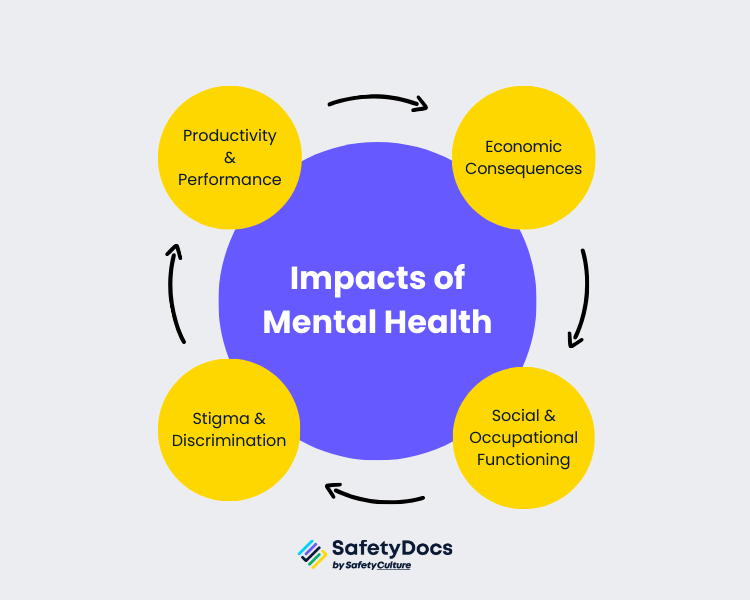Every year, more than 4 million Australians encounter mental health challenges and require treatment and recent data released by the Australian Bureau of Statistics indicates Australia's suicide rate stands at 12.7 deaths per 100,000 individuals. According to the Productivity Commission, Australia's existing mental health system is inadequate in its coverage. Implementing reforms in this area would yield significant advantages for individuals experiencing mental health conditions.
This blog aims to delve into the evolving landscape of occupational health, shedding light on the significance of prioritising mental health alongside the more conventional aspects.
The Shifting Paradigm of Occupational Health
Historical Emphasis on Physical Health
Traditionally, occupational health is centred around physical well-being, with minimal attention to mental health. Over the past few decades, there was a growing recognition of the importance of physical activity for health and well-being. Policies were developed to promote physical activity and included initiatives to encourage active transportation, such as walking or cycling, and to ensure that all Australians have access to opportunities for physical activity.
Changing Attitudes Towards Mental Health Awareness
More recently, there has been a shift towards a more holistic view of health, recognising the interconnectedness of physical and mental health. While Australians still tend to focus more on their physical health, there is a growing understanding that mental and physical health are equally important.
National Mental Health Commission's Vision 2030
One of the most recent developments in Australia's mental health landscape is the National Mental Health Commission's Vision 2030. This vision aims to promote a mentally healthy and inclusive society by 2030, with an emphasis on prevention, early intervention, and accessible support for all Australians experiencing mental illness.
Key aspects of Vision 2030 include:
- Promoting mental well-being across the lifespan, including in work and education
- Ensuring that mental health is understood and acknowledged as part of everyone's experience
- Offering well-coordinated community-based services that are easily navigated and tailored to meet individual needs, helping to prevent escalating concerns.
Vision 2030 is part of the federal Department of Health's 10-year plan. It aims to maintain consistency with the Productivity Commission's inquiry into Mental Health and many other state, territory, and national activities. The vision sets a framework to ensure a consistent approach towards the same goals for Australia's future mental health system.

Impact of Mental Health
The change in Australia's mental health landscape comes with the realisation of the significant impact that mental well-being has on individuals, families, communities, and societies.
Economic Consequences
Poor mental health has a considerable economic impact, with an estimated cost to the Australian economy of approximately $10.9 billion per year. This can be quantified by considering factors such as the combined costs of absenteeism, presenteeism, and compensation claims across various industries within a year. This comprehensive measurement provides valuable insights into the economic implications of mental health on businesses and organisations.
Social and Occupational Functioning
Mental health conditions can impact a person's social and occupational functioning, including their ability to maintain employment, form and maintain relationships, and participate in daily activities. This can result in reduced productivity, increased absenteeism, and higher turnover rates within the workplace.
Stigma and Discrimination
There is also a persistent stigma and discrimination surrounding mental health that often prevents individuals from seeking support and treatment. This can contribute to individuals experiencing prolonged symptoms and difficulties, further affecting their productivity and well-being.
Productivity and Performance
Prioritising mental health in the workplace is essential for maintaining a productive workforce. Studies have shown that organisations with supportive workplace cultures, where employees feel safe to discuss their mental health concerns, have lower turnover rates and higher levels of job satisfaction. Additionally, employees who regularly address mental health and engage in self-care strategies, such as taking breaks and seeking support when needed, tend to have higher productivity and performance throughout their careers.

Common Stressors in the Modern Workplace
The modern workplace can cause significant stress for many individuals.The most common reasons for work-related mental stress in Australia are work pressure (31%), work-related harassment and/or bullying (27%), and workplace change (26%). Here are more of the most common stressors:
- Excessive Workload: Overwhelming work can lead to burnout, fatigue, and reduced productivity. This is especially prevalent in high-pressure industries or roles that require long hours.
- Lack of Control: Feeling like you have no control over your work or decisions can be a significant source of stress. This includes being unable to influence decisions that affect your job or feeling unclear about expectations.
- Work-Life Balance: As remote work and technology blur personal and professional boundaries, balancing work and life has become more challenging.
- Job Security: Economic uncertainty and organisational changes can create fear of layoffs or job loss, significantly contributing to stress levels.
- Interpersonal Conflict: Dealing with difficult coworkers, managers, or clients can create a hostile work environment, leading to increased stress.
- Lack of Support: A lack of support from management or colleagues can leave employees feeling isolated and overwhelmed.
- Role ambiguity: Unclear job expectations or confusion about duties and responsibilities can lead to anxiety and stress.
- Technology Stress: Rapid changes in technology and the pressure to learn new tools and software can also be a source of stress. Additionally, the constant connectivity can make it challenging to disconnect and relax after work.
Employer Responsibilities
Leadership has a crucial role in promoting mental health in the workplace. Employers, being the key decision-makers, have the power to shape the culture and policies of the workplace. Under the WHS laws, a person conducting a business or undertaking (PCBU) must:
1. Manage Psychosocial Risks
The PCBU must manage risks to mental health in consultation with the workers and health and safety representatives using the risk management process. This process involves identifying hazards, assessing the risks that may harm mental health, and implementing controls to eliminate or minimise them.
2. Support Employees
Employers are encouraged to create a mentally healthy environment by supporting every employee. This support can take many forms, including providing resources for mental health, accommodating flexible work arrangements, and fostering a positive work culture.
3. Comply with Legal Obligations
Employers must help employees suffering from mental health conditions and ensure they don't face discrimination in the workplace. They must also work closely with medical professionals when deciding about an employee's mental health condition.
4. Provide a Safe Working Environment
The PCBU must provide a safe working environment that includes addressing psychosocial risks. This includes promoting mental health strategies, training and educating staff on mental health awareness and supporting individuals experiencing mental health difficulties.
Employee Responsibilities
While employers play a crucial role in promoting workplace mental health, employees also have responsibilities to maintain their well-being and support others. These include:
1. Self-Care
Employees must prioritise self-care and well-being by taking breaks, setting boundaries, and seeking support when needed.
2. Open Communication
Workers should feel safe to express their mental health concerns or struggles with their employers and colleagues.
3. Knowledge and Awareness
Employees should educate themselves about mental health and be aware of the resources available in the workplace.
4. Supporting Others
Being supportive and understanding towards colleagues experiencing mental health difficulties can help create a positive work environment. This can include active listening, offering assistance, or simply showing empathy.

Creating a Mentally Healthy Workplace
Creating and maintaining a mentally healthy workplace requires collaboration and effort from both employers and employees. The organisation must take various steps to achieve this, such as:
Implement policies and procedures that support mental well-being.
Safety policies and procedures must include mental health as a priority. This can involve developing protocols for managing work-related stress or promoting work-life balance. For example, an organisation can implement flexible work arrangements or provide resources for mental health support.
Provide resources and support.
Employers should provide access to resources such as Employee Assistance Programs (EAPs), counselling services, and mental health first aid training. These resources can help employees manage their mental health and seek support when needed.
Regularly conduct mental health check-ins.
Employers can conduct anonymous surveys or have open discussions with employees to monitor their well-being and identify areas for improvement. You can use this data to develop targeted strategies and support programs.
Encourage a supportive work culture.
Leadership should promote a positive and inclusive work culture where employees feel comfortable discussing mental health issues and seeking support. This can involve promoting open communication, normalising mental health conversations, and addressing mental health stressors.
Fulfil Your Responsibilities with SafetyDocs
Let us assist you in fulfilling your responsibilities to create a mentally healthy workplace. SafetyDocs by SafetyCulture provides businesses with resources and tools to promote mental health in the workplace. With our pre-made templates and checklists, you can quickly develop safety policies and procedures and monitor employee well-being.
Start using these documents and discover how helpful SafetyDocs can be for your organisation:
- Psychosocial Hazards Management Plan
- Psychosocial Hazards Policy
- Bullying Policy
- Occupational Health & Safety Policy
Contact us today to learn more about how we can support mental health at work. Let's work towards happier and mentally healthy workplaces.
Our team of experts is dedicated to providing accurate and informative content. Craig Cruickshank, our senior HSEQ advisor at SafetyDocs by SafetyCulture has reviewed this blog post to ensure the highest level of quality.
Learn more about Craig's work on LinkedIn for more industry insights.
Available for instant download and supplied in fully editable MS Word format for use in your business.
Please note that the above information is provided as a comment only and should not be relied on as professional, legal or financial advice.
Share This Article
